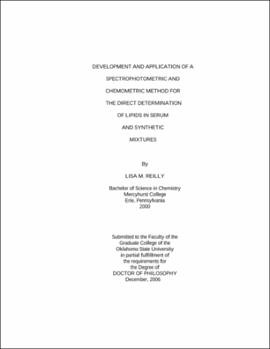| dc.contributor.advisor | Purdie, Neil | |
| dc.contributor.author | Reilly, Lisa M | |
| dc.date.accessioned | 2013-11-26T08:21:29Z | |
| dc.date.available | 2013-11-26T08:21:29Z | |
| dc.date.issued | 2006-12 | |
| dc.identifier.uri | https://hdl.handle.net/11244/6472 | |
| dc.description.abstract | Scope and Method of Study: Polyunsaturated fatty acids (PUFA) have become a focus in both nutritional sciences and medical studies in the evaluation of risk factors for cardiovascular diseases, dyslipidemias, diabetes, obesity, and other diseases. Studies have disclosed that unsaturated fatty acids can offer health benefits which include reducing cardiovascular death rates, lowering blood pressure, and promoting positive health effects for patients with other diseases. However, other studies have demonstrated the involvement of unsaturated fatty acids in the development of atherosclerosis, metabolic syndrome, and other diseases. With the potential connections of fatty acids to various diseases, the development of a direct, inexpensive, and routine colorimetric assay for the measurement of the concentration of serum lipids would enable a PUFA to be incorporated fully as a risk factor for any disease. | |
| dc.description.abstract | Findings and Conclusions: Our research group has focused on the use of a patented reagent developed by Dr. Purdie that is selective to --C-C=C- groups and results in a unique ultra-violet/visible spectrum for cholesterol and the PUFA. The resulting spectrum from a serum or mixture sample is a composite of all seven components. Multivariate analysis methods that have been applied to the de-convolution of the spectral data are: principal component analysis (PCA); partial least squares (PLS); simple standard addition (SAM), generalized standard addition (GSAM); and artificial neural networks (ANN). The comparative results for the same, prepared samples comprised of individual standards up to seven component mixtures using ANN, GSAM, and PLS chemometric algorithms had root mean square error of prediction on the order of 1-20% indicative of a rugged assay procedure. Overall, the ANN results are superior to the other two computational methods. The combination of the Purdie assay and chemometric methods has created a simple, direct method for the determination of cholesterol and PUFA concentrations. Further studies, with examination of the method applied to serum, will conclusively demonstrate the full capabilities of this assay. | |
| dc.format | application/pdf | |
| dc.language | en_US | |
| dc.rights | Copyright is held by the author who has granted the Oklahoma State University Library the non-exclusive right to share this material in its institutional repository. Contact Digital Library Services at lib-dls@okstate.edu or 405-744-9161 for the permission policy on the use, reproduction or distribution of this material. | |
| dc.title | Development and application of a spectrophotometric and chemometric method for the direct determination of lipids in serum and synthetic mixtures | |
| dc.contributor.committeeMember | Apblett, Allen | |
| dc.contributor.committeeMember | Lavine, Barry | |
| dc.contributor.committeeMember | Mort, Andrew | |
| dc.contributor.committeeMember | Rockley, Mark | |
| osu.filename | Reilly_okstate_0664D_2107.pdf | |
| osu.accesstype | Open Access | |
| dc.type.genre | Dissertation | |
| dc.type.material | Text | |
| thesis.degree.discipline | Chemistry | |
| thesis.degree.grantor | Oklahoma State University | |
